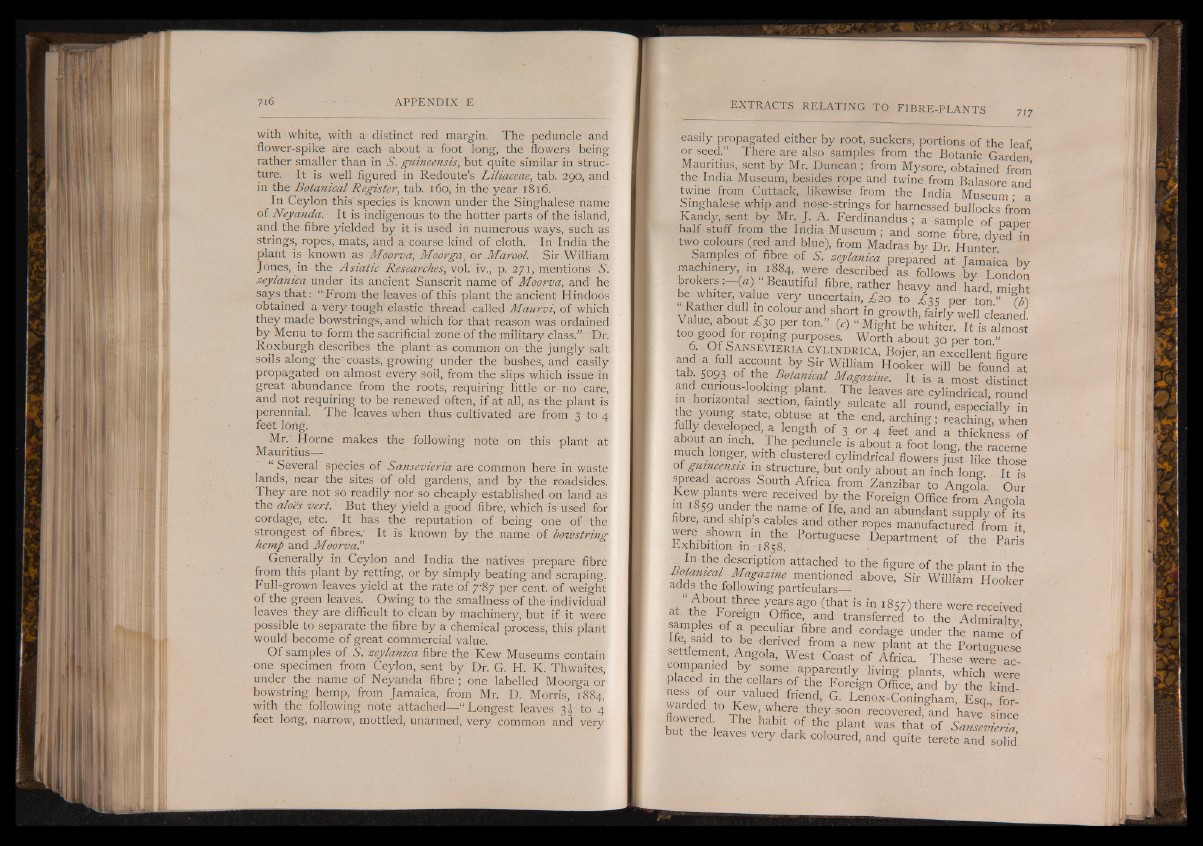
with white, with a distinct red margin. The peduncle and
flower-spike are each about a foot long, the flowers being
rather smaller than in S. guineensis, but quite similar in structure.
It is well figured in Redoute’s Liliaceae, tab. 290, and
in the Botanical Register, tab. 160, in the year 1816.
In Ceylon this species is known under the Singhalese name
of Neyanda. It is indigenous to the hotter parts of the island,
and the fibre yielded by it is used in numerous ways, such as
strings, ropes, mats, and a coarse kind of cloth. In India the
plant is known as Moorva, Moorga, or Marool. Sir William
Jones, in the Asiatic Researches, vol. iv., p. 271, mentions S'.
zeylanica under its ancient Sanscrit name of Moorva, and he
says that: “ From the leaves of this plant the ancient Hindoos
obtained a very tough elastic thread called Maurvi, of which
they made bowstrings, and which for that reason was ordained
by Menu to form the sacrificial zone of the military class.” Dr.
Roxburgh describes the plant as common on the jungly salt
soils along the coasts, growing under the bushes, and easily
propagated on almost every soil, from the slips which issue in
great abundance from the roots, requiring little or no care,
and not requiring to be renewed often, if at all, as the plant is
perennial. The leaves when thus cultivated are from 3 to 4
feet long,
Mr. Horne makes the following note on this plant at
Mauritius^-
“ Several species of Sansevieria are common here in waste
lands, near the sites of old gardens, and by the roadsides.
They are not so readily nor so cheaply established on land as
the aloes vert. But they yield a good fibre, which is used for
cordage, etc. It has the reputation of being one of the
strongest of fibres.” It is known by the name of bowstring
hemp and Moorva”
Generally in Ceylon and India the natives prepare fibre
from this plant by retting, or by simply beating and scraping.
Full-grown leaves yield at the rate of 7-87 per cent, of weight
of the green leaves. Owing to the smallness of the individual
leaves they are difficult to clean by machinery, but if it were
possible to separate the fibre by a chemical process, this plant
would become of great commercial value.
Of samples of S. zeylanica fibre the Kew Museums contain
one specimen from Ceylon, sent by Dr. G. H. K. Thwaites,
under the name of Neyanda fibre ; one labelled Moorga or
bowstring hemp, from Jamaica, from Mr. D. Morris, 1884,
with the following note attached— “ Longest leaves M to 4
feet long, narrow, mottled, unarmed, very common and very
easily propagated either by root, suckers, portions of the leaf
or seed.” There are also samples from the Botanic Garden’
Mauritius, sent by Mr. Duncan; from Mysore, obtained from
the India Museum, besides rope and twine from Balasore and
twine from Cuttack, likewise from the India Museum ■ a
Singhalese whip and nose-strings for harnessed bullocks from
Kandy, sent by Mr. J. A. Ferdinandus ; a sample of o a S
half stuff from the India Museum; and some fibre, dyed in
two colours (red and blue), from Madras by Dr. Hunter
Samples of fibre of S. zeylanica prepared at Jamaica by
machinery in 1884, were described as follows by London
brokers: (a) Beautiful fibre, rather heavy and hard, might
be whiter, value very uncertain, £20 to ner ton ” ^
“ Rather dull in colour and short in growth, fairly well cleaned
Value, about.¿30 per ton.” (c) “ Might be whiten It is almost
too good for roping purposes. Worth about 30 per ton ”
6. Of S a n s e v i e r i a c y l i n d r i c a , Bojer, a n excelled figure
and a full account by Sir William Hooker will be found £
tab. 5993 of the Botanical Magazine. It is a most distinct
and curious- ooking plant. The leaves are. cylindrical round
in horizontal section, faintly sulcate all round, especially in
the young state, obtuse at the end, arching; reaching, when
about an Inch Tb ^ H i 3 ° u 4 feet about an inch. The peduncle is about a foaont dl onag ,t hthicek nraecses moef
much longer, with clustered cylindrical flowers just like th<Se
of guineensis in structure, but only about an inch long. It is
spread across South Africa from Zanzibar to Angola. Our
Kew plants were received by the Foreign Office from Angola
fibre -r> u,ame and an abundant supply of its
re, and ship s cables and other ropes manufactured from it
Port“ S“^ Department o f the Paris’
In the description attached to the figure of the plant in the
Mlie smaid fto abbeeP ^deUr ived/ ffrroem a nad n°e°wr dpalgaen tu natd etrh et hPeo rntaumguee soef
settlement, Angola, West Coast of Africa. These w e r f a S
r 7 iSi°me aPParent,y living plants, which were
placed m the cellars of the Foreign Office, and by the kind-
® ° f our valued friend, G. Lenox-Coningham Esq forwarded
to Kew, where they soon recovered, and have since
flowered. The habit of the plant was that of Sansevieria
but the leaves very dark coloured, and quite terete and solid